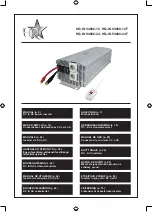
Aquair 100
TM
Manual
© Ampair
®
, 2007
www.ampair.com
Page 10 of 23
CONVERSION FROM TOW MODE TO WIND (for HIR kit):
Conversion:
Find a suitable location for suspending the Aquair 100. The fore triangle is a safe area
away from the cockpit. Remove the locking rings from the clevis pins and remove clevis pins, and pivot
pins from the acetal bushes to release the generator. If stiff to remove, the bushes may be gently prised
out by introducing a small lever
through the holes in the sides of
the pivot housings and engaging
the groove in the bush. If
completely corroded in, then fill
centre hole with grease and use
pivot pin as a piston to knock into
hole
and
force
bush
out.
Otherwise, the bush will have to
be drilled out and replaced.
Remove
the
acetal
shaft
connector.
Swivel Poles:
Attach the swivel
poles to the generator “ears” using
the M8x50mm bolts, shake-proof
washers and nuts provided. Do not
fit the turbine and tail vane.
Suspension:
Partially hoist the
Aquair 100 to enable assembly of
the tail vane and wind turbine. To
minimise sway, connect the lower
swivel to the deck by three guys at
approximately 120 degrees to
each other, viewed from above.
Do not apply excessive tension
since this will result in rapid wear
of the PTFE swivel bearings.
Cable:
Secure the output wire to
the lower swivel pole, allowing as
much slack as possible without
causing the cable to snag in the
turbine.
Wind vane:
Using the three
M6x16mm screws, washers and
nuts provided, fit the vane (tail fin)
to the rear of the Aquair body.
Wind turbine assembly:
First,
check that the hub plates are
correctly fitted to the hub-centre.
(Some plates had a small hole
near one of the 12 blade fixing
holes and these should line up.)
The blades are supplied as colour
coded pairs (see the colour code
on the blade base). These pairs
should be assembled finger tight
to the hub, in opposite positions,
using the M8x40mm bolts shake-
proof washers and nuts provided.
The bolts are a deliberately tight fit
but may be screwed in using a socket spanner.
Note. The concave (hollow) side of the blade faces the wind.
Tighten the blade bolts working on opposite pairs in sequence. It is a good idea to re-tighten fixings
after a few hours use since some compression of the materials may have taken place. It is usual to
Figure 8: Aquair Hoist In Rigging Mounting









































